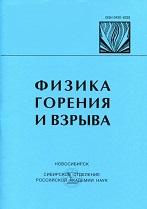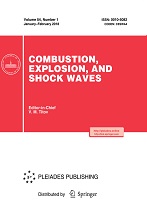|
This article is cited in 9 scientific papers (total in 9 papers)
Ultrahigh cooling rates at the interface of explosively welded materials and their effect on the formation of the structure of mixing zones
I. A. Bataev, D. V. Lazurenko, Yu. N. Malyutina, A. A. Nikulina, A. A. Bataev, O. È. Mats, I. D. Kuchumova
State Technical University, Novosibirsk, 630073, Russia
Abstract:
Explosively welded metal plates are characterized by the formation of local microvolumes at the interlayer boundaries within which there is a mixing of interacting materials. These microvolumes can be located discretely along wavy boundaries or continuously in the form of thin interlayers along planar boundaries. Based on the results of many published works, it has been shown that the material in these zones is melted, and its subsequent solidification occurs at a high rate leading to the formation of metastable phases. In this paper, the formation of metastable phases in steel-steel, $\mathrm{Ta}$-steel, $\mathrm{Nb}$–$\mathrm{Al}$, and $\mathrm{Zr}$–$\mathrm{Cu}$ joints is analyzed. The cooling rates of these materials in mixing zones is estimated. Calculations show that the cooling rate of the melts formed in the welded zones of the investigated composites is in the range $10^3-10^6$ K/s. Cooling of mixing zones at such high rates results in the formation of metastable structures. In some cases, the crystallization of materials is suppressed and metallic glasses and quasicrystalline phases are formed in the melt zones.
Keywords:
explosion welding, high cooling rates, metastable structures.
Received: 24.04.2017
Citation:
I. A. Bataev, D. V. Lazurenko, Yu. N. Malyutina, A. A. Nikulina, A. A. Bataev, O. È. Mats, I. D. Kuchumova, “Ultrahigh cooling rates at the interface of explosively welded materials and their effect on the formation of the structure of mixing zones”, Fizika Goreniya i Vzryva, 54:2 (2018), 122–130; Combustion, Explosion and Shock Waves, 54:2 (2018), 238–245
Linking options:
https://www.mathnet.ru/eng/fgv497 https://www.mathnet.ru/eng/fgv/v54/i2/p122
|


| Statistics & downloads: |
| Abstract page: | 49 | | Full-text PDF : | 16 |
|





 Contact us:
Contact us: Terms of Use
Terms of Use
 Registration to the website
Registration to the website Logotypes
Logotypes








 Citation in format
Citation in format 
